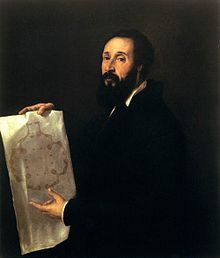Giulio Romano
| Giulio Romano | |
|---|---|

Titian's Portrait of Giulio Romano (ca. 1536), oil on canvas, 101 x 86 cm
|
|
| Born | 1499 Rome |
| Died | November 1, 1546 Mantua |
| Nationality | Italian |
| Known for | painting, fresco, architecture |
Giulio Romano, also known as Giulio Pippi, (c. 1499 – 1 November 1546) was an Italian painter and architect. A pupil of Raphael, his stylistic deviations from high Renaissance classicism help define the 16th-century style known as Mannerism. Giulio's drawings have long been treasured by collectors; contemporary prints of them engraved by Marcantonio Raimondi were a significant contribution to the spread of 16th-century Italian style throughout Europe.
Giulio Romano was born in Rome; the "Romano" refers to this. As a young assistant in Raphael's studio, he worked on the frescos in the Vatican loggias to designs by Raphael and in Raphael's Stanze in the Vatican painted a group of figures in the Fire in the Borgo fresco. He also collaborated on the decoration of the ceiling of the Villa Farnesina. Increasingly he became the master's right-hand man, despite his relative youth. After the death of Raphael in 1520, he helped complete the Vatican frescoes of the life of Constantine as well as Raphael's Coronation of the Virgin and the Transfiguration in the Vatican. In Rome, Giulio decorated the Villa Madama for Cardinal Giuliano de' Medici, afterwards Clement VII. The crowded Giulio Romano frescoes lack the stately and serene simplicity of his master.
From 1522 he was courted by Federico Gonzaga, ruler of Mantua, who wanted him as court artist, apparently especially attracted by his skill as an architect. In late 1524 Giulio agreed to move to Mantua, where he remained for the rest of his life. He thus avoided the disaster of the Sack of Rome in 1527, which hugely disrupted artistic patronage in Rome and dispersed the remains of Raphael's workshop. Vasari tells how Baldassare Castiglione was delegated by Federico Gonzaga to procure Giulio to execute paintings and architectural and engineering projects for the duchy of Mantua. His masterpiece of architecture and fresco painting in that city is the suburban Palazzo Te, with its famous illusionistic frescos (c. 1525–1535). He also helped rebuild the ducal palace in Mantua, reconstructed the cathedral, and designed the nearby Church of San Benedetto. Sections of Mantua that had been flood-prone were refurbished under Giulio's direction, and the duke's patronage and friendship never faltered: Giulio's annual income amounted to more than 1000 ducats. His studio became a popular school of art.
...
Wikipedia
